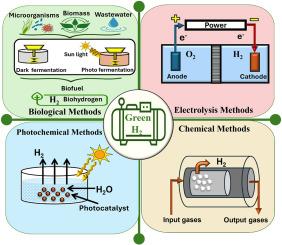From theory to practice: Evolving methods and challenges in green hydrogen production
IF 16.3
1区 工程技术
Q1 ENERGY & FUELS
引用次数: 0
Abstract
Hydrogen is emerging as a cornerstone of the clean energy transition, offering a high-density, zero-carbon fuel for decarbonizing electricity, heat, industry, and mobility. Among various pathways, green hydrogen—produced via water or biomass splitting using renewable energy—presents the most sustainable route, with near-zero lifecycle CO2 emissions. This review systematically evaluates key green hydrogen production methods, including electrolysis (alkaline electrolysis, proton exchange membrane electrolysis, solid oxide electrolysis cell, and high-temperature steam electrolysis), chemical routes (biomass gasification, methane pyrolysis, hydrogen sulfide splitting), photo-based techniques (photoelectrochemical and photocatalytic), biological systems, hybrid processes (solar-thermal, wind-to-H2, geothermal), and emerging technologies (plasma decomposition, nuclear-driven, and ocean energy hydrogen). A comparative analysis is provided on efficiency (1–90 %), energy consumption (30–60 kWh/kg H2), cost ($2–6/kg), technology readiness (TRL 3–9), and scalability. While electrolysis remains the frontrunner due to high efficiency and integration with renewables, biohydrogen and methane pyrolysis offer promising synergies with waste valorization and carbon co-products. Advanced solar-thermal and photo-based systems show long-term potential but remain in early development. Despite rapid progress, challenges persist in capital cost, durability (e.g., PEC >1,000 h), and infrastructure integration. Global levelized costs are projected to fall below $2–3/kg by 2030 with policy incentives and falling renewable prices. Accelerating commercialization will require continued research and development in materials, modular system design, and supportive frameworks such as carbon pricing, tax credits, and green hydrogen targets.

从理论到实践:绿色制氢的发展方法和挑战
氢正在成为清洁能源转型的基石,为电力、供热、工业和交通脱碳提供高密度、零碳燃料。在各种途径中,利用可再生能源通过水或生物质分解产生的绿色氢是最可持续的途径,其生命周期二氧化碳排放量接近于零。本文系统评价了主要的绿色制氢方法,包括电解(碱性电解、质子交换膜电解、固体氧化物电解电池和高温蒸汽电解)、化学途径(生物质气化、甲烷热解、硫化氢裂解)、光基技术(光电化学和光催化)、生物系统、混合工艺(光热、风能制氢、地热)、新兴技术(等离子体分解、核能驱动和海洋能氢)。对效率(1 - 90%)、能耗(30-60 kWh/kg H2)、成本(2-6美元/kg)、技术成熟度(TRL 3-9)和可扩展性进行了比较分析。虽然电解由于效率高和与可再生能源的结合而仍然是领先者,但生物氢和甲烷热解与废物增值和碳副产品具有很好的协同作用。先进的太阳能热和基于光的系统显示出长期潜力,但仍处于早期发展阶段。尽管进展迅速,但在资本成本、耐久性(例如,PEC >1,000 h)和基础设施集成方面仍然存在挑战。由于政策激励和可再生能源价格下降,预计到2030年全球平准化成本将降至每公斤2-3美元以下。加速商业化将需要在材料、模块化系统设计和支持性框架(如碳定价、税收抵免和绿色氢目标)方面继续进行研究和开发。
本文章由计算机程序翻译,如有差异,请以英文原文为准。
求助全文
约1分钟内获得全文
求助全文
来源期刊

Renewable and Sustainable Energy Reviews
工程技术-能源与燃料
CiteScore
31.20
自引率
5.70%
发文量
1055
审稿时长
62 days
期刊介绍:
The mission of Renewable and Sustainable Energy Reviews is to disseminate the most compelling and pertinent critical insights in renewable and sustainable energy, fostering collaboration among the research community, private sector, and policy and decision makers. The journal aims to exchange challenges, solutions, innovative concepts, and technologies, contributing to sustainable development, the transition to a low-carbon future, and the attainment of emissions targets outlined by the United Nations Framework Convention on Climate Change.
Renewable and Sustainable Energy Reviews publishes a diverse range of content, including review papers, original research, case studies, and analyses of new technologies, all featuring a substantial review component such as critique, comparison, or analysis. Introducing a distinctive paper type, Expert Insights, the journal presents commissioned mini-reviews authored by field leaders, addressing topics of significant interest. Case studies undergo consideration only if they showcase the work's applicability to other regions or contribute valuable insights to the broader field of renewable and sustainable energy. Notably, a bibliographic or literature review lacking critical analysis is deemed unsuitable for publication.
 求助内容:
求助内容: 应助结果提醒方式:
应助结果提醒方式:


